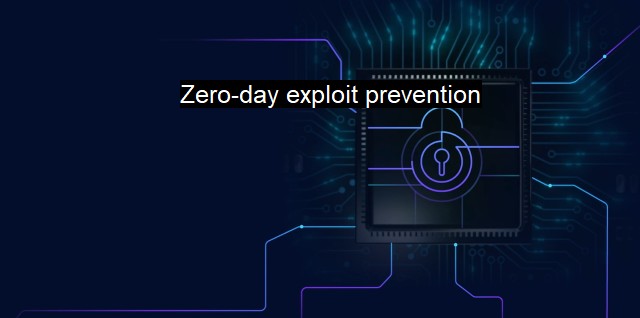What is Zero-day exploit prevention?
Zero-Day Exploit Prevention: Advanced Strategies for Thwarting Complex Malware Attacks and Protecting Sensitive Data
In the sphere of cybersecurity and antivirus, "Zero-day Exploit Prevention" is often described as the shield against unknown threats. A zero-day exploit is a term used to describe the situation in which a vulnerability, unknown to the software creators or vendors, is exploited by cybercriminals to infiltrate a system, application or network before it can be rectified or a defensive action can be implemented.Zero-day exploits are a tricky infiltration process as they capitalise on the vulnerabilities previously unknown to security experts – the faults, weaknesses, or bugs within the system, software, or applications – therefore proving notoriously tough to anticipate and guard against. The term ‘zero-day’ reflects the fact that developers have zero days to create a patch and protect against the vulnerability since it is already being exploited.
In view of this emerging challenge, Zero-day Exploit Prevention is a specialized cybersecurity strategy that is being widely adopted and implemented. it envolves implementing measures and security mechanisms to deflect or diminish the impact of zero-day attacks, by meticulously examining applications or systems to detect irregular behavior or anomalies that point towards a zero-day exploit.
The context of Zero-day Exploit Prevention primarily revolves around the development and implementation of advanced protective software components such as sandboxes, firewalls, intrusion prevention systems (IPS), endpoint detection and response systems (EDR), and real-time threat intelligence feeds. These protective measures constructively isolate and test novel software and intrusions within a secured environment before they are allowed to run on the network, thereby reducing the risk of an unknown exploit wreaking havoc.
Adopting a technological approach for protection involves uniquely created solutions that emphasize threat intelligence, behavioral analysis, and real-time response rather than traditional blacklisting techniques. Thus, preventing unknown threats from evolving into full-blown security breaches. The goal is to reduce the attack surface and continuously shield the system or network from unknown vulnerabilities.
It's worth noting though that no defensive approach is foolproof, and vigilance plays a crucial role in the cybersecurity landscape. Many experts espouse the need for proactive countermeasures, such as timely updates of all software, maintaining constant system health checks, diffusing an attack concurrency, keeping systems segregated, and ensuring adequate staff cybersecurity training.
Despite putting up the myriad of defensive strategies, one must not undermine the potential of a robust backup strategy as a preventive measure in disrupting the threats of zero-day exploits, as it can ensure data retrieval in the face of an unforeseen catastrophic event.
The implementation of Zero-day Exploit Prevention strategies should not deflect from the reality that no entity is fully immune from cyber threats. Security comes with a price, and equally crucial is the recognition that the disputes are as much about data as they are about defenses: compromised information can have devastating impacts on businesses, institutions, and on a personal level.
In generating a culture of cybersecurity awareness and constantly leveraging on advanced threat intelligence, combined with the evolving Zero-day Exploit Prevention strategies and cybersecurity measures, it may be possible to form an effective defense-in-depth strategy against the complex web of zero-day vulnerabilities. As the landscape of cyber threats continues to evolve, the quest for cybersecurity preparedness and enhancements endures to stay as the first line of defense, with zero-day exploit prevention gaining in the ranks of importance within the broader cybersecurity protection matrix.

Zero-day exploit prevention FAQs
What is a zero-day exploit?
A zero-day exploit is a cyber attack that takes advantage of a software vulnerability that is unknown to the software vendor and for which there is no patch or fix available.How can zero-day exploits be prevented?
Zero-day exploits can be prevented by using advanced threat prevention technologies, such as next-generation antivirus software, intrusion prevention systems, and behavior-based detection tools. It is also important to keep your software up-to-date and to apply security patches as soon as they become available.What are the benefits of zero-day exploit prevention?
The benefits of zero-day exploit prevention include enhanced cyber security, reduced risk of data breaches and cyber attacks, and improved business continuity. By preventing zero-day exploits, organizations can protect their sensitive data and intellectual property, maintain customer trust, and avoid costly regulatory fines and legal liability.How can I ensure that my organization is effectively protected against zero-day exploits?
To ensure that your organization is effectively protected against zero-day exploits, you should work with a reputable cybersecurity provider that offers a comprehensive suite of threat prevention and remediation services. You should also establish robust cybersecurity policies and best practices, provide regular employee training, and conduct regular vulnerability assessments and penetration testing to identify and address potential vulnerabilities.| | A | | | B | | | C | | | D | | | E | | | F | | | G | | | H | | | I | | | J | | | K | | | L | | | M | |
| | N | | | O | | | P | | | Q | | | R | | | S | | | T | | | U | | | V | | | W | | | X | | | Y | | | Z | |
| | 1 | | | 2 | | | 3 | | | 4 | | | 7 | | | 8 | | |||||||